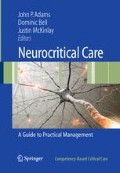Key Points
-
1.
NICE guidelines are available in the United Kingdom to decide which patients should have a CT brain scan after head injury.
-
2.
CT is not always a good predictor of functional outcome. MRI may have better prognostic value.
-
3.
Early CT may underestimate the actual size of a brain parenchymal lesion.
-
4.
Diffuse axonal injury (DAI) should always be suspected in the presence of intraventricular hemorrhage or small intraparenchymal hemorrhages in key areas such as the cerebral hemispheres, corpus callosum, brainstem, and areas adjacent to the third ventricle. Nearly 80% of DAI lesions are microscopic and not visible on any imaging modality.
-
5.
MRI has a limited role in the acute situation.
Access this chapter
Tax calculation will be finalised at checkout
Purchases are for personal use only
References
Al-Nakshabandi NA (2001) The swirl sign. Radiology 218(2):433
Baker WE, Wassermann J (2004) Unsuspected vascular trauma: blunt arterial injuries. Emerg Med Clin North Am 22(4):1081–98
Brooks WM, Friedman SD et al (2001) Magnetic resonance spectroscopy in traumatic brain injury. J Head Trauma Rehabil 16(2):149–164
Caroli M, Locatelli M et al (2001) Multiple intracranial lesions in head injury: clinical considerations, prognostic factors, management, and results in 95 patients. Surg Neurol 56:82–88
Cell P, Fruin A et al (1997) Severe head trauma: review of the factors influencing the prognosis. Minerva Chir 52:1467–1480
Coles JP (2007) Imaging after brain injury. Br J Anaesth 99(1):49–60
Dublin B, French BN et al (1977) Computed tomography in head trauma. Radiology 122:365–369
Early Management of Patients with a Head Injury. Scottish Intercollegiate Guidelines Network (SIGN), August 2000.
Emmanuel A, Stamatakis JT, Lindsay Wilson et al (2002) SPECT imaging in head injury interpreted with statistical parametric mapping. J Nucl Med 43(4):476–483
Frowein RA, Schiltz F, Stammler U (1989) Early post traumatic intracranial hematoma. Neurosurg Rev 12:184–187
Gallagher CN, Hutchinson PJ et al (2007) Neuroimaging in trauma. Curr Opin Neurol 20(4):403–409
Gennarelli TA, Thibault LE (1982) Biomechanics of subdural hematoma. J Trauma 22:680–685
Gentry LR, Godersky JC et al (1989) Traumatic brain stem injury: MR Imaging. Radiology 171(1):177–187
Harris John H (1999) The radiology of emergency medicine, 4th edn. Lippincott Williams & Wilkins publication, Philadelphia, PA, p 20
Hou DJ, Tong KA et al (2007) Diffusion-weighted magnetic resonance imaging improves outcome prediction in adult traumatic brain injury. J Neurotrauma 24(10):1558–1569
Le T, Gean A (2006) Imaging of head trauma. Semin Roentgenol 41(3):177–189
Martin Smith (2008) Monitoring intracranial pressure in traumatic brain injury. Anesth Analg 106:240–248
Metting Z, Rodiger LA et al (2007) Structural and functional neuroimaging in mild-to-moderate head injury. Lancet Neurol 6(8):699–710
Morais DF, Spotti AR et al (2008) Clinical application of magnetic resonance in acute traumatic brain injury. Arq Neuropsiquiatr 66(1):53–58
Parizel PM, Ozsarlak O et al (1998) Imaging findings in diffuse axonal injury after closed head trauma. Eur Rad 8:960–965
Reed D, Robertson WD, Graeb DA et al (1986) Acute subdural hematomas: Atypical CT findings. AJNR 7:417–421
Servadei F (1997) Prognostic factors in severely head injured adult patients with epidural haematomas. Acta Neurochir (Wien) 139(4):273–278
Sugiyama K, Kondo T et al (2007) Diffusion tensor fiber tractography for evaluating diffuse axonal injury. Brain Inj 21(4):413–419
Triage, assessment, investigation and early management of head injury in infants, children and adults, National Institute of Clinical Excellence (NICE) guidelines, September 2007.
Wintermark M, Reichhart M et al (2002) Prognostic accuracy of cerebral blood flow measurement by perfusion computed tomography, at the time of emergency room admission, in acute stroke patients. Ann Neurol 51:417–432
Wintermark M, van Melle G et al (2004a) Admission perfusion CT: Prognostic Value in Patients with Severe Head Trauma. Radiology 232:211–220
Wintermark M, van Melle Guy et al (2004b) Admission Perfusion CT: Prognostic Value in Patients with Severe Head Trauma. Radiology 232:211–220
Yoshihiro Toyama, Takuya Kobayashi et al (2005) CT for Acute Stage of Closed Head Injury. Radiation Medicine 23(5):309–316
Zimmerman RA, Bilaniuk LT (1982) Computed tomographic staging of traumatic epidural bleeding. Radiology 144:809–812
Zimmerman RA, Bilaniuk LT et al (1977) Computed tomography of acute intracerebral hemorrhagic contusion. Comp Ax Tomogr 1:271–279
Zumkeller M, Behrmann R et al (1996) Computed tomography criteria and survival rate for patients with acute subdural hematomas. Neurosurgery 39(4):708–712
Author information
Authors and Affiliations
Editor information
Editors and Affiliations
Rights and permissions
Copyright information
© 2010 Springer-Verlag London Limited
About this chapter
Cite this chapter
Goddard, T., Mankad, K. (2010). Imaging the Brain-Injured Patient. In: Adams, J., Bell, D., McKinlay, J. (eds) Neurocritical Care. Competency-Based Critical Care. Springer, London. https://doi.org/10.1007/978-1-84882-070-8_14
Download citation
DOI: https://doi.org/10.1007/978-1-84882-070-8_14
Published:
Publisher Name: Springer, London
Print ISBN: 978-1-84882-069-2
Online ISBN: 978-1-84882-070-8
eBook Packages: MedicineMedicine (R0)

